Why is heat dissipation necessary for electronic devices?
Failure to properly control the heat generated inside electronics can lead to poor performance, shortened product life, and even explosion or fire.
Semiconductor components (ICs, transistors, etc.), capacitors, resistors, and other elements mounted on the PCB have specified operating temperatures. If these temperatures are exceeded, they may stop operating, or the components may be damaged.
Therefore, heat dissipation measures are required to ensure safe operation within the temperature specified in the specification.
In particular, as technology develops, overheating issues are increasing due to the miniaturization and high integration of semiconductors (reduced line width, etc.).Since it is mounted at a high density on the PCB, the heat is transferred to other components and results in a chain effect of increasing the temperature of the entire PCB.
Heat dissipation is to transfer of heat generated from a heat source to a heatsink through a thermal interface material and radiating it into the atmosphere. The material and performance of the thermal interface and heat sink and the heat dissipation design for smooth airflow are important factors.
Heat Transfer
To prevent the chipset or system from malfunctioning due to overheating, a radiator (heatsink) is attached to the heat source to lower the temperature. Thermal interface materials are placed between the radiator and the heat source to stimulate heat transfer.
Heat transfers with conduction, convection, and radiation.
- Conduction: heat transfer from materials of high temperature to those of low temperature when they are in contact
- Convection: heat transfer through flowing gas or liquid
- Radiation: remote heat transfer through heat as a form of wave
The conventional cooling method utilizes all three types of heat transfers: conduction through the thermal interface material, convection through the surrounding air, and radiation through the attached radiator.
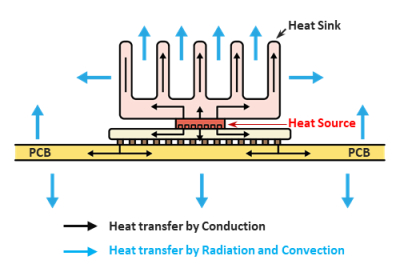
Thermal Interface Material: Heat conduction and spread
Some properties are required for thermal interface material for effective heat transfer between the heat source and the radiator.
- Excellent heat conductivity
- Adhesiveness; to minimize the air gaps
- Minimization of hotspot in the heat source; to dissipate the heat to the entire area of thermal interface material
- Its surface area should be as large as possible.
- Its thickness should be as thin as possible.
Thermal Interface Material
Commonly used thermal interface material, silicone thermal pad, is an adequate material to attach between chip sets or PCB plates and the radiator. Silicone thermal pad has excellent adhesiveness and softness due to silicone's property, which effectively reduces the air gap. However, the thermal conductivity is not very good because it is made by adding thermally conductive ceramic powder to silicon, an insulating material. The silicone thermal pad thermal conductivity is only 1-5W/mK, while those of copper and aluminum are 385 and 205 W/mK. Making the pad thin enough solves the conductivity issue to some extent, which still allows it to be popular in the market.
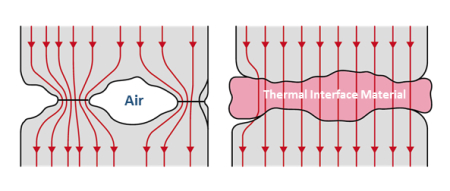
Heat Spreader
When the heat source is wide and the hotspot is located far from the center, utilizing the whole area of thermal interface material to spread heat faster is effective. The vertical conductivity of the heat spreader is equal to or slightly higher than that of a silicone thermal pad. Still, heat spreader has an enormous lead in horizontal conductivity, which allows it to disperse the hotspot and spread the heat. For example, the thermal conductivity of a graphite sheet is 5-8W/mK vertically but 400-800W/mK horizontally.
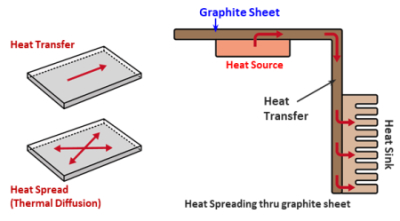
Products
There are many thermal interface materials, and some popular varieties are listed below.
Silicone Thermal Pad
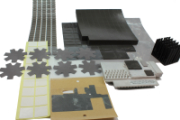
The silicone thermal pad is made by fixing thermally conductive ceramic powders (alumina, BN) inside molten silicone, and adhesives are applied on each side. Products of a thickness of 0.5-10mm and a heat transfer coefficient of 1-5W/mK are widely used.
- Advantages: soft and adhesive, economic, and easy to die-cut
- Disadvantages: low thermal conductivity, lower conductivity at high thickness, low compressibility, leakage of silicone oil, which may corrode attaching parts of small molecule siloxane, costly as the product gets thicker, high density and weight issue
Ultra-thin Thermal Sheet
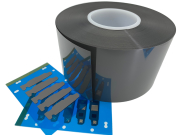
The ultra-thin thermal pad is a thin pad of 0.1-0.3mm: applicable to mobile devices.
- Advantages: suitable for use on the heat source of small devices due to its thin thickness.
- Disadvantages: high hardness, no inherent adhesiveness, needing to apply additional adhesive for use
Thermal Foam Gasket
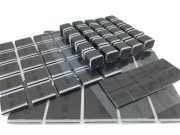
The thermal foam gasket is made by wrapping heat-resistant core materials with a graphite sheet. Thermally conductive double-sided tape is applied on one side to allow the gasket to be attached to the heat source easily.
It only conducts heat through the conductive surface material (graphite sheet); therefore, it is more effective with higher horizontal conductivity and thickness of the material. The surface graphite is wrapped with a thin film to prevent graphite particles from falling.
- Advantages: There is little to no difference in heat resistance, even if the heat source and the radiator are distant. Vibration absorption due to soft interior, less weight issue even if multiple of the product is placed inside a large system
- Disadvantages: Less effective than a thermal pad in thin products (1-3mm)





